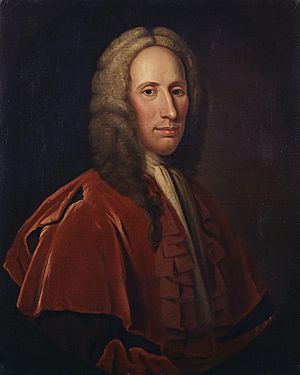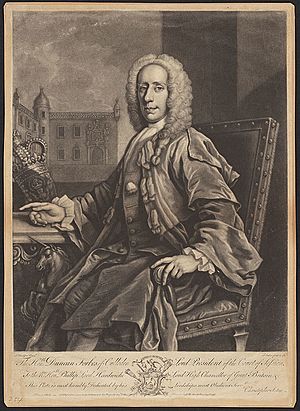Jeremiah Davison facts for kids
Jeremiah Davison (born around 1695 – died around 1750) was a talented British painter. He was especially known for his amazing portrait paintings.
Early Life and Artistic Training
Jeremiah Davison was born in England around 1695. His parents were from Scotland. From a young age, he showed a great interest in art.
Davison learned a lot by studying the paintings of famous artists like Sir Peter Lely. He also trained with Joseph van Aken, who taught him a special skill: how to paint fabrics like satin so they looked incredibly real and shiny. This skill made his portraits even more impressive.
Davison passed away around 1750, when he was about 50 years old.
Becoming a Famous Portrait Painter
Jeremiah Davison became friends with important people, which helped his career. Through a group called a Masonic lodge, he met James Murray, 2nd Duke of Atholl. The Duke was very impressed with Davison's work and had his portrait painted.
With the Duke and Duchess of Atholl's support, Davison traveled to Scotland. He quickly became a very popular portrait painter there, working in cities like Edinburgh. He also continued to paint in London, gaining many clients.
Notable Works and Subjects
Davison painted many important people during his career. In 1730, he painted a portrait of Frederick, Prince of Wales, who was the son of the King.
You can still see some of his paintings today in famous places:
- At Greenwich Hospital, there is a full-length portrait of Admiral George Byng, 1st Viscount Torrington.
- The National Gallery of Scotland has a painting of Richard Cooper, the elder.
- In the Merchants' Hall in Edinburgh, you can find a portrait of Elizabeth Macdonald of Largie.
- A painting of the famous actress Kitty Clive was once owned by Horace Walpole at his home, Strawberry Hill.
- A group portrait showing James Douglas, 14th Earl of Morton and his family is now in the Scottish National Portrait Gallery.
Jeremiah Davison's paintings give us a wonderful look at the important people and fashion of the 18th century.



